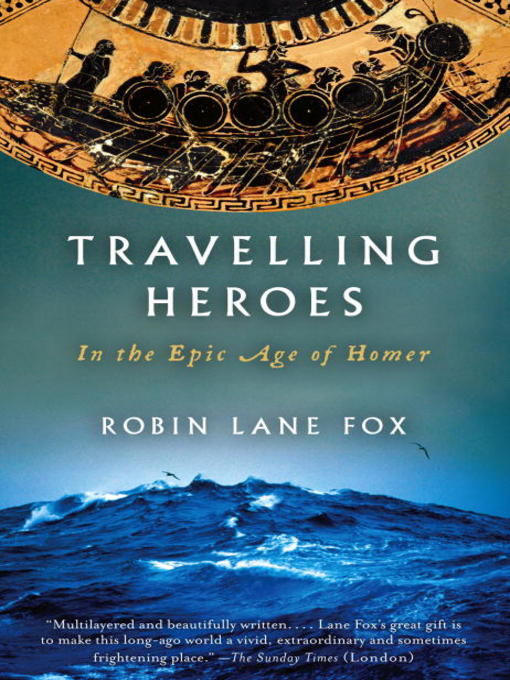
Travelling Heroes
کتاب های مرتبط
- اطلاعات
- نقد و بررسی
- دیدگاه کاربران
نقد و بررسی

April 1, 2009
Intellectual detective work sifts fact from mystery in the stories spread across the ancient world by Greek adventurers.
Though not an archaeologist, Fox (Ancient History/Oxford Univ.; The Classical World, 2006, etc.) seems to possess a precise mental catalogue of every significant pottery shard recently surfaced in the Mediterranean and Near East. Equally important, he knows what has not yet been found and acknowledges it, often with anticipation. These objects, along with the excavated sites of ancient habitation, burial mounds, cemeteries and shipwrecks, comprise an extraordinary, if sometimes tentative roadmap of the roving Greeks' trajectory in the eighth century BCE. They traveled east and west, trading, raiding and sometimes settling in a time of cultural awakening. Virtually illiterate since Mycenaean Era syllabic script had been abandoned 400 years earlier, they adapted a Semitic alphabet around 750 BCE. They took with them, in oral tradition, the epic poems of Homer and the myths in which heroes from a glorious past challenged the gods, performed miraculous feats, won great victories, slew monsters, avenged rape and murder, rescued kidnapped virgins, etc. Tracing the impact of these"travelling stories" throughout the world the Greeks influenced, the author's acumen shines like a beacon. For example, cults to Heracles (Hercules to the Romans) spread from Asia Minor to Spain; place names attributable to Io, a maiden seduced by Zeus and transformed into a cow, track the migration of those stories eastward from Argos. Fox focuses on the island of Euboea as an origin of the travelers, citing proven links along with tantalizing leads. Throughout, his intellectual discipline is impressive."Culture-heroes do approximately similar things is different societies," he stresses, warning against"mistaking parallel stories for causes and origins." Fox notes that although Homer's tales were of the distant past, the poet was"often precise" about landscapes and places from his own time.
Heady stuff for those with interest in the subject, but so dense that casual history buffs may fall by the wayside.
(COPYRIGHT (2009) KIRKUS REVIEWS/NIELSEN BUSINESS MEDIA, INC. ALL RIGHTS RESERVED.)

May 15, 2009
Fox (university reader, ancient history, Oxford Univ.; "The Unauthorized Version") has produced a work of prodigious scholarship, with a title deceptive in its simplicity since the book is about more than Odysseus and his ilk. In fact, Fox explores cultural exchanges between Greece and the areas to the East during the eighth century B.C.E., when the "Iliad" and "Odyssey" were written. In particular, the Euboean Greeks played an important role in these exchangesa theory Fox demonstrates with enviable skill, drawing on archaeological and mythic evidence. Each chapter's footnotes are a joy to read on their own merit but also give cohesiveness to a work definitely intended for the experts; despite Fox's facile writing style, this text is not for the fainthearted. That said, the book is a major contribution to Classical scholarship and will be read by teachers of the mythology, archaeology, and literature of the region ranging from Syria to Italyand beyond in both directions. A case in point: Fox demonstrates that the mythical giants of Syria were still affecting the literature during the Italian Renaissance. Strongly recommended for all serious readers in Classical studies.Clay Williams, Hunter Coll., New York
Copyright 2009 Library Journal, LLC Used with permission.

March 15, 2009
Oxford classicist Fox explores the 700s BCE, the century to which he imputes the composition of the Iliad and the Odyssey. Explaining that this was an era of cultural contact between Greeksspecifically, those from the island Euboeaand residents of the eastern littoral of the Mediterranean Sea, he delves deeply into the nature of that exchange. Aiming to evoke the Euboeans mind-set, he springs from the archaeological traces of their settlements to the gods and heroes of the Near East they adapted into their own myths. While there is considerable textual explication of Homer and Hesiod involved in Foxs procedure, he pulls the mythical characters from the pages and places them in the physical landscapes with which the Euboeans not only associated them but believed they actively inhabited. So doing lends the appealing impetus of travel writing to Foxs account that aids readers in absorbing the world of pagan belief. Detailed but recurrently on point, Fox will connect with readers drawn to the Homeric age.(Reprinted with permission of Booklist, copyright 2009, American Library Association.)

























دیدگاه کاربران